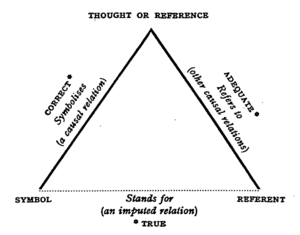Symbology/Triad
The triangle of reference
[edit | edit source]
In The Meaning of Meaning (1923), the authors C. K. Ogden and I. A. Richards put forward what they call the "triangle of reference." For them, SYMBOL in language on the one hand and REFERENT in reality on the other are not related (directly) by themselves, hence the dotted bottom, but (indirectly) by way and by virtue of THOUGHT or REFERENCE in mind on the top that is hence the central concern. This cognitive, psycholinguistic, user-centered idea is the point of departure of of their "study of the influence of language upon thought and of the science of symbolism," as mentioned as the subtitle.
Accordingly, language that is supposed to make reference to reality should be suspected of its ambiguity and uncertainty, and therefore should be reasonably interpreted by cognitive "human intelligence," which on the other hand is built up through the triangle of reference or the "Delta Factor," as suggested by Walker Percy (1975) elsewhere. Consequently, such approaches as cognitivism and interpretivism have been emphasized more and more especially since the late 1970s.
- ↑ Any other nomenclature such as "semiotic triangle" is strictly unfounded, likely used to water down its originality.
